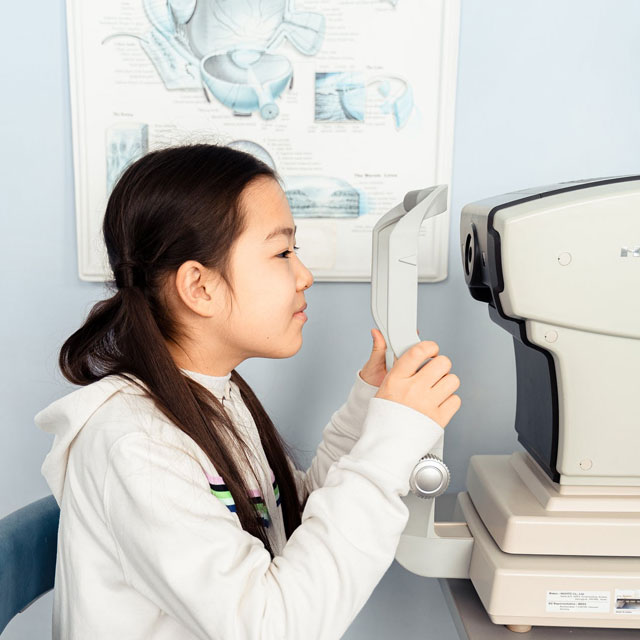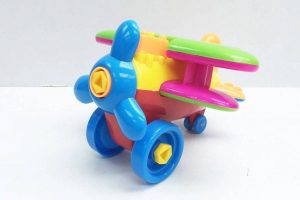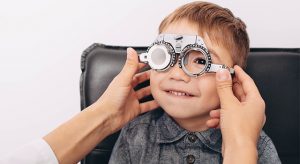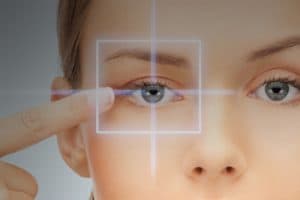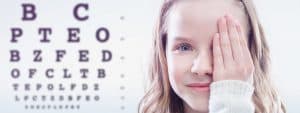Is your child reading below grade level or have attention difficulties? Your child may have hyperopia.
Hyperopia is another term used to describe long or far-sightedness.
According to the National Eye Institute and the U.S. Department of Health and Human Services, up to 10% of Americans suffer from some degree of hyperopia.
Hyperopia affects 1 in 7 children and can significantly impact your child’s learning, reading and overall school performances.
Here are our top 8 frequently asked questions about hyperopia in children.
Q1: What is hyperopia?
Hyperopia (farsightedness) is a common condition that affects people of all ages.
Up to 14% of school-age students have farsightedness but it often goes undetected in children.
As light and other visual information enters through the lens, it is focused on the back of the eye, known as the retina. However, with hyperopia, the shape of the eye causes the light entering the eye to focus further back, behind the retina.
In adults, this condition makes close-up objects and images appear blurry while distance vision remains clear.
However in children, hyperopia rarely causes blurry vision as they can focus their eyes harder to compensate for the far-sightedness.
The primary problem faced by school-age children is that hyperopia causes eye strain, fatigue and significantly affects the child’s ability to achieve their potential.
Q2: What causes hyperopia?
Hyperopia results from one of several causes:
- The eyeball is shorter than normal
- The cornea is less curved than normal
- The lens is thinner than normal
The majority of children with hyperopia inherit the condition from their parents. However, it can also be caused by developmental issues in utero or in early childhood.
Other conditions such as Aniridia, Fragile X Syndrome or Down Syndrome, and traumatic damage to the eye can seriously increase the chances of developing hyperopia.
Q3: What are the primary signs of hyperopia in children?
Most children never complain of blurry vision, but if your child shows any difficulties at school, they may have undiagnosed hyperopia.
Signs and symptoms of hyperopia include:
- Not achieving their potential at school or any reading, learning, or attention difficulties
- Headaches or fatigue after near vision activities, such as reading, writing, or computer use
- Eye strain caused by squinting or other accommodations to keep images and objects in focus
- Images or objects appearing blurry at close distance, while distance vision remains clear
- Holding material like books, a mobile phone or tablet at arm’s length
- Inward eye turn when trying to focus
In mild cases, your child may not notice a significant problem with their sight. They may, however, still experience headaches or fatigue after activities like reading, writing or using a computer.
In more serious cases of hyperopia, your child may find it hard to see clearly at any distance. This happens because the muscles in and around the eye get fatigued by the constant need to refocus, causing additional vision issues.
Q4: Can hyperopia be prevented?
Hyperopia is not preventable. In most cases children inherit it from their parents.
However, with regular eye exams, hyperopia can be diagnosed early, to help prevent issues with learning and other issues.
Early detection is also important to prevent the development of further complications, such as accommodative esotropia, which can severely harm a person’s vision if not treated early in life.
Q5: How do optometrists diagnose hyperopia?
Vision screenings such as those given at school and in optical-only stores to determine a contact lens or eyeglass prescription are unlikely to detect hyperopia.
In most children, the only way to diagnose long-sightedness is with an eye exam.
In order to detect hyperopia, your child’s eye doctor will perform a comprehensive eye exam that may include diagnostic equipment such as a retinoscope to detect refractive errors, and a phoropter to measure the precise level of the refractive errors once identified.
These tools will help the eye doctor determine the extent of your child’s farsightedness and which glasses or contact lens prescription will provide them with the clearest, most comfortable vision.
SEE RELATED: Guide to Pediatric Eye Conditions
Contact an eye doctor near you if your child is showing signs of a vision problem.
Q6: How is hyperopia treated?
Several options are available to correct hyperopia and prevent the many problems that children can experience.
1. Eyeglasses
Most children with hyperopia are treated with eyeglasses. Those with a higher optical prescription should wear their glasses full time, while those with lower levels of hyperopia may not need glasses at all except when reading, writing, or doing other types of near work.
2. Bifocal/Multifocal lenses
These lenses are beneficial for children with focusing difficulties or accommodative esotropia.
They contain two or more lenses of different strengths and are often given to patients that have different optical prescriptions, for both near vision and distance vision.
3. Contact lenses.
These are generally prescribed for older children. Contact lenses offer clear vision at all distances and a wider field of view than eyeglasses.
Contact lenses are placed directly on the eye, so good hygiene practices are essential to prevent infection.
Q7: Can Vision therapy help hyperopia?
If a student experiences fatigue or tiredness from hyperopia, often vision therapy can improve their visual skills.
Many parents do not want their child to wear glasses and prefer to strengthen their child’s visual system with vision therapy.
Q8: Can hyperopia affect my child’s ability to learn in school?
Yes.
Hyperopia can impact your child’s ability to learn.
Recent university studies conducted at Ohio State University and published in Optometry and Vision Science (Oct, 2017) have shown that many children with hyperopia struggle in school, and have lower scores on tests of visual attention, visual perception, and visual-motor integration (eye-hand coordination or copying skills) when compared to children without hyperopia.
When children with hyperopia do a lot of close work like reading and writing, this often results in blurry vision, headaches, and eye strain.
Discomfort resulting from hyperopia can also cause children to become frustrated and have difficulty concentrating while attempting these activities.
Q8: What happens if hyperopia goes untreated?
Adults tend not to be affected by complications from undiagnosed or untreated hyperopia.
Children with hyperopia are more likely to develop complications, such as learning or attention difficulties, during school.
Untreated hyperopia can cause a number of issues, including:
- Lazy eye (amblyopia)
- Eyes that aren’t aligned (strabismus)
- Accommodative esotropia
- Developmental delays in children
- Learning problems in school and at home
LEARN MORE: Children’s Vision
Contact an eye doctor near you if your child is showing signs of a vision problem.
Hyperopia affects over 14% of children and can significantly impact a child’s learning, reading and overall school performances.
Here’s the top 8 frequently asked questions about hyperopia in children.
